Menu
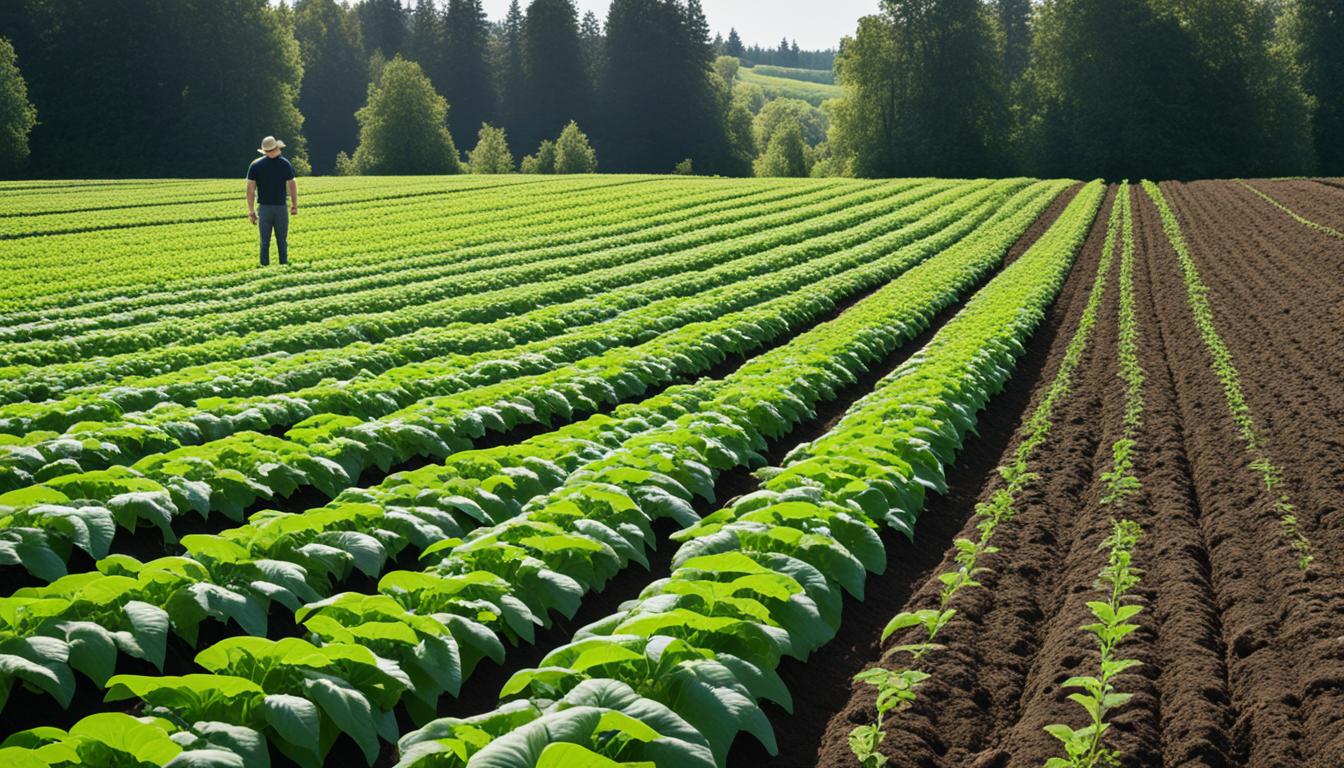
Fields with cover crops in no-till systems can see less erosion. This helps keep topsoil strong for farming and our food supply. It shows how cover crops greatly improve soil health.
The USDA Natural Resources Conservation Service lists four key points for cover cropping. These are keeping the soil covered, lessening disturbance, encouraging plants to grow all year, and trying different crops. Cover crops like rye, clovers, and radishes protect the soil after harvests. They help with no-till farming, add to biodiversity, and boost farm income. This is by improving soil, balancing nutrients, and guarding the soil.
Cover cropping is key in modern farming. It protects and nourishes the soil between main crops. By planting fast-growers like rye and clover, the soil stays healthy and full of life. We will explore what cover crops are, their beginnings, and how they help farming stay sustainable.
Cover crops, such as rye, clovers, and radishes, are not grown for direct harvest. They’re planted to shield the soil and improve it. They fight off pests, diseases, and make farms more profitable. Planted after main harvests, they are vital for keeping the soil productive.
Cover cropping goes way back to ancient times. It was crucial for managing soil and having varied crops. Today, it’s even more important. For example, in late 2021, the U.S. Department of Agriculture planted cereal rye to boost soil and fight winter weeds. This shows that cover cropping is still key in sustainable farming.
There are many cover crops, each with its own benefits for farming. Grasses like rye and barley suck up nutrients well. Some grasses pull nitrogen from the air and put it back in the soil. This helps the soil naturally. Radishes do a great job at making hard soil softer, which helps water soak in better.
This mix of cover crops helps in developing complete soil health plans. It lets farmers pick the best cover crops for their needs. This encourages diversity in plants and rotations on farms.
Using cover crops makes farming more sustainable. It does more than keep the soil healthy. It supports a strong ecosystem for lasting farm success.
Cover crops are key to making soil healthier. They do this by improving how soil organisms work together, by protecting soil from the weather, and by making soil richer in nutrients. These actions help farms stay healthy for the long term.
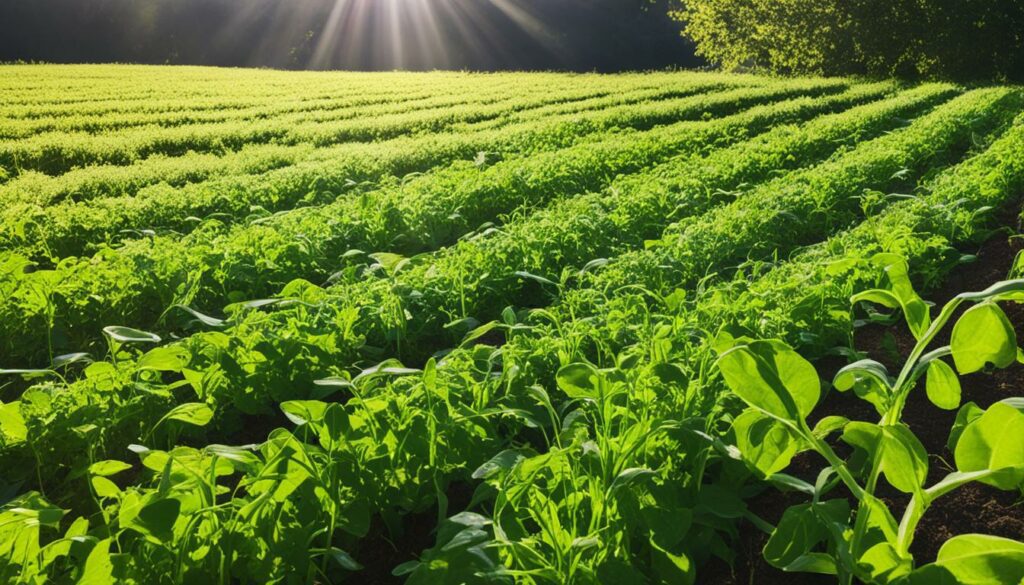
Cover crops boost soil health by encouraging the growth of helpful organisms. They release sugars from their roots, which feed many tiny living things in the soil. These soil friends help to provide nutrients to the plants, creating a balanced system. This makes more nutrients available and supports a wide variety of life in the ground.
Cover crops physically shield the soil. They prevent rain from hitting the soil directly, reducing erosion. They also stop the soil from compacting and keep nutrients from washing away, especially in the wet seasons. This makes the fields easier to work on. The plants’ roots create pathways, helping water sink in and air reach deeper, which is great for the soil’s health.
Cover crops are also vital for improving soil chemically. They help store carbon and manage nutrients better, reducing the need for extra fertilisers. These crops boost the soil’s richness and structure. For example, legumes help by adding nitrogen, lowering the need for artificial chemicals. This method makes the land better over years and keeps farming sustainable.
“Attending regionally specific workshops and networking events enables farmers to stay updated on the latest cover crop research and learn from other agricultural professionals.”
The choice of cover crop and when it’s sown are very important. Working with experts and using tools like the USDA’s NRCS Cover Crop Economics Tool can make a big difference. This helps farmers get the most out of cover cropping, making their land healthier.
| Benefits | Impact |
|---|---|
| Biological Soil Interactions | Improves nutrient availability and fosters dynamic soil ecosystems. |
| Physical Soil Protection | Reduces erosion, mitigates compaction, and enhances water infiltration. |
| Chemical Soil Enhancement | Bolsters soil carbon sequestration, improves nutrient management, and reduces fertiliser needs. |
There are more heavy rains in the Northeastern United States now. This makes soil erosion and nutrient runoff worse. Cover crops become very important for controlling erosion in this wetter weather.
Cover crops help to naturally control erosion. They create a shield with their green leaves that protects the soil. This shield stops the soil from washing away when it rains hard. The roots of these crops also keep the soil together, making it strong against heavy rain.
It’s vital to use the right methods to take full advantage of cover crops. These include choosing different types of crops, not disturbing the soil too much, and always keeping the ground covered. These steps make the soil richer, hold water better, and build soil that doesn’t wash away easily.
So, here’s some data to show how effective cover crops can be at stopping erosion:
| Cover Crop Type | Soil Loss Reduction |
|---|---|
| Non-Legume Cover Crops | 31% to 100% |
| Legume Cover Crops | 38% to 69% |
| Mustard Cover Crops | Up to 82% |
Look at the numbers above. They clearly show how much cover crops help. They protect the soil basically completely during dangerous times. This not just keeps the soil healthy. It also helps farming stay good for the long haul.
Cover crops are great for stopping weeds without needing lots of herbicides. They create a thick layer that blocks out sunlight and uses up water and nutrients. This makes it hard for weeds to grow. Zeb Winslow saw a big drop, about 50%, in his herbicide use by planting many kinds of cover crops. These included rye, triticale, oats, and crimson clover. These crops helped him control pests and weeds naturally.
Farmers who switch from ploughing their fields all the time to no-till use much less fuel. They save over four gallons of diesel per acre each year. Using cover crops to stop weeds also saves money and helps the environment. It shows how good cover cropping is for both the planet and the wallet.
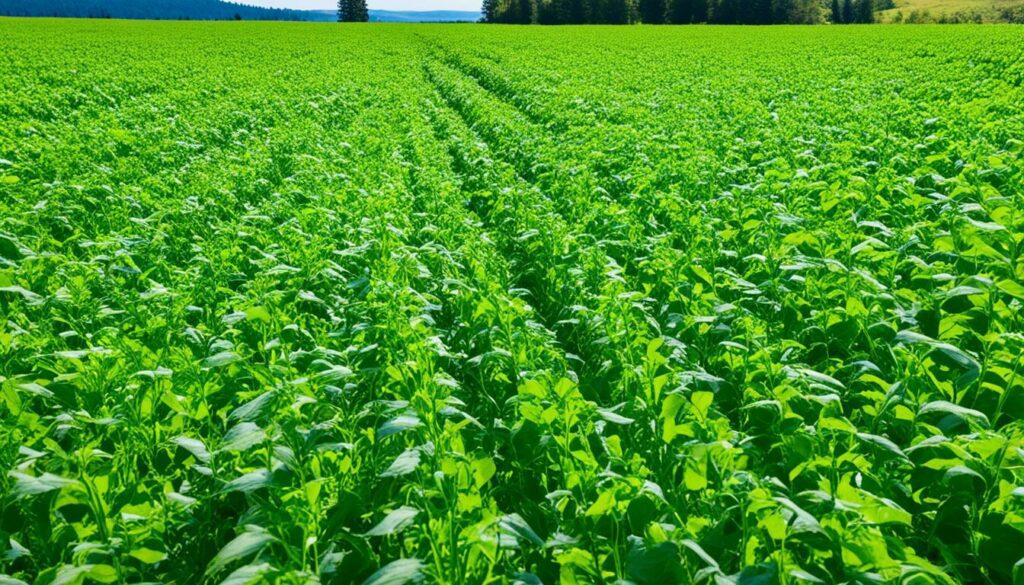
It’s best to stop cover crops from growing too late using chemicals or machines. Weed suppression stays better this way. When planting, you need more seeds if you just scatter them compared to using a machine to plant. This makes sure the whole field is covered well with the crops. Cover crops not only fight weeds but also make the field healthier and more stable. They help create a better environment for farming.
Cover crops are vital in boosting water conservation and enhancing soil moisture retention on farms. Their deep roots and the organic matter they add help to keep water in the soil. This reduces the need for a lot of watering.
Using a mix of different cover crops is particularly effective for keeping the soil moist. A study in Bladen, Nebraska, found that such mixes saved water just as well as using only wheat stubble. Plus, they helped grow more corn. This shows that using different crops can make farming both more efficient and resilient.
Grasses like rye, wheat, and sorghum-sudangrass are great for cutting down how much water evaporates. They’re important because they make the soil hold together better and let water soak in more. This helps the ground keep more water, which is good for the crops.
Cover crops are also a big help in bad dry spells, increasing the amount of food grown even then. A survey found that planting cover crops meant farmers could get 9.6% more corn and 11.6% more soybeans when there wasn’t much rain. This help isn’t just good for growing food, it also means they can make money. So, planting cover crops can pay for itself in just one year, with benefits from $27.34 to $110.45 per acre for corn and $41.69 to $84.54 per acre for soybeans.
| Cover Crop Type | Benefit | Example |
|---|---|---|
| Grasses | Reduces evaporation, improves soil aggregation | Rye, Wheat, Sorghum-Sudangrass |
| Legumes | Enhances nitrogen content, improves water retention | Hairy Vetch, Austrian Winter Peas |
| Radishes | Breaks up soil compaction, increases pore space | Tillage Radish |
Using cover crops is not just good for growing more food. It helps farm sustainably too. Cover crops keep the soil moist, making sure crops have enough water while they grow. This is key to their health and the amount of produce they give.
Cover crops are key in keeping the soil fertile and improving nutrient cycling. They help increase the soil’s organic matter. This leads to many benefits for farming.
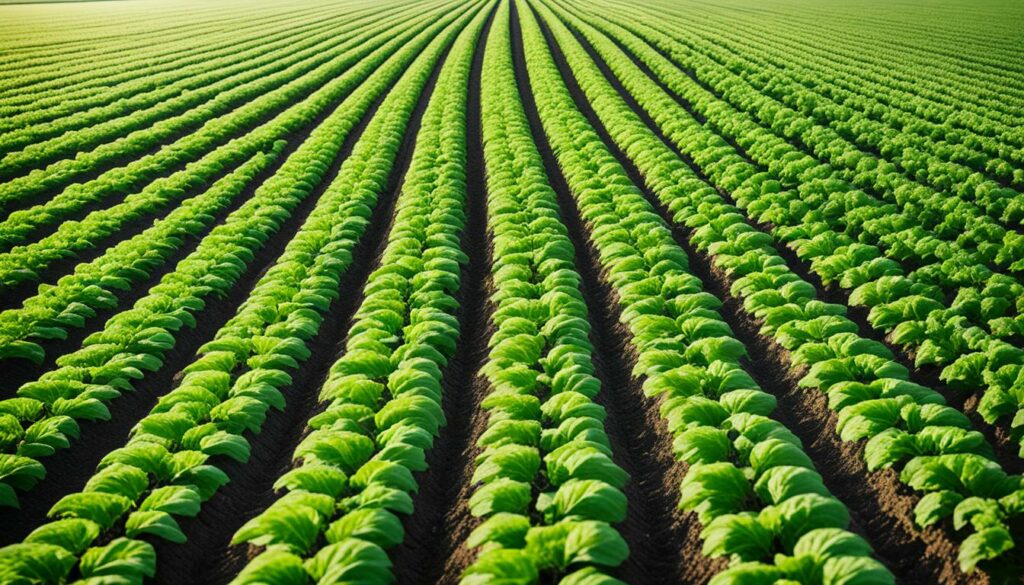
Cover crops boost soil organic matter and affect nutrient cycling and soil make-up. For instance, legume cover crops like hairy vetch and medium red clover are good for soil. They turn air’s nitrogen into plant-ready form, adding nitrogen to the soil for future crops.
Legume cover crops, such as Austrian winter peas and hairy vetch, can meet up to all the nitrogen needs of later crops. This means less need for synthetic fertilisers. It saves money for farmers and is better for the environment.
Using cover crops means less need for store-bought fertilisers. A study in Wisconsin showed medium red clover with oats and hairy vetch can replace up to 103 pounds of nitrogen per acre. This is a big cost and eco benefit.
Also, grains and grasses sown in autumn can take in 71 pounds of nitrogen per acre in three months. This boosts soil quality and stops loss of nutrients. It makes nutrients more available for the next crops without lowering yields.
These methods help nutrients keep cycling. This supports long-lasting soil fertility and healthy farm environments. By focusing on boosting organic matter, farmers create sustainable, productive farms.
| Cover Crop | Nitrogen Contribution | Study Location |
|---|---|---|
| Austrian Winter Peas | 80-100% | Pacific Northwest |
| Hairy Vetch | Increased crop yields | Maryland |
| Medium Red Clover | 65-103 lbs/acre | Wisconsin |
By planting cover crops like these, farmers can boost soil fertility without heavy use of chemical fertilisers.
Cover crops are vital for making biodiversity thrive. They create homes for different creatures, above and below the earth. This makes the soil richer and a great place for plants to grow.
With heavy rains in the Northeastern United States, soil erosion is a big problem. Cover crops stop the soil from being washed away. They also help keep nutrients from flowing off the land.
Wetter weather in the spring and autumn limits the days people can work in the fields. Cover crops solve this by improving the soil. They make the soil hold more water, create better structure, and enhance biodiversity.
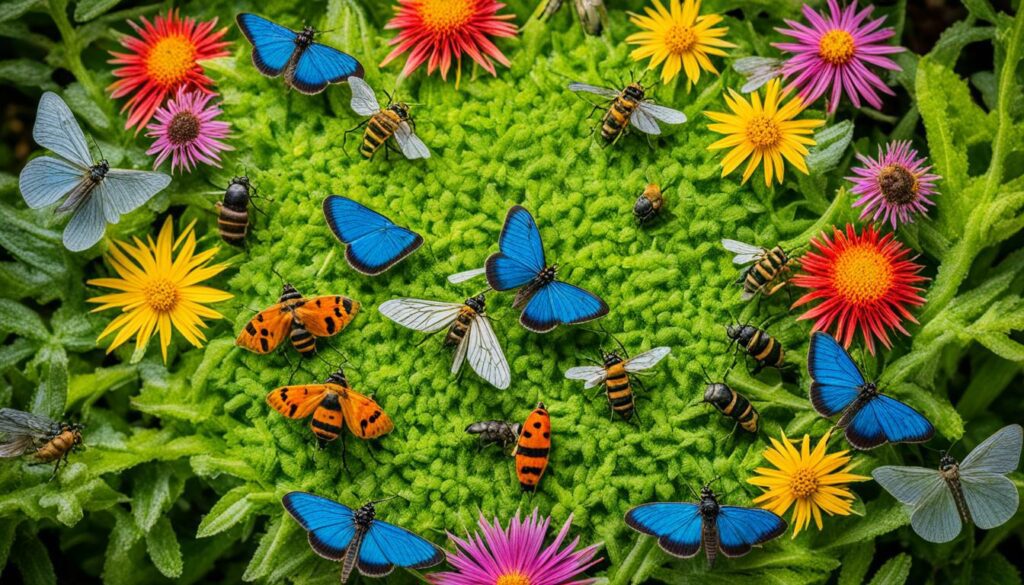
Cover crops do something amazing by lessening water pollution and taking in CO2. They also keep extra nutrients ready for the next crop to use. So, they help the environment in many ways.
One big plus is how much they help the tiny creatures in the soil. These include arthropods, which are insects like spiders and bugs. Cover crops increase their numbers. This is very good because these insects help control pests and make the soil healthier.
By adding cover crops to farmlands, we create homes for helpful creatures like bees. This is seen a lot in pear orchards across the European Union. These places have seen more insects that eat pests. As a result, the need for pesticides has gone down.
Although starting with cover crops can cost a bit, they save money in the long run. They boost crop growth, lower the need for heavy machinery, and fight off weeds and diseases. On top of that, they help wildlife and make the land more diverse.
Cover crops are key to fighting climate change. They alone can trap 60 million metric tons of CO2 each year. This is like taking 12.8 million cars off the road. It shows how cover crops help lower greenhouse gas emissions.
To understand how effectively cover crops trap carbon, we need to study the soil well. Researchers say we must sample the soil to a depth of 30 inches. If we don’t, we miss recording 30% to 61% of the actual carbon storage. This deeper soil carbon is important. So it’s vital to start by knowing the soil’s natural carbon levels.
Using the right mix of cover crops can boost soil carbon storage. Crops like cereal rye, crimson clover, and oilseed radish work well. They help in the capture of carbon. A review of 26 studies backs up the benefits of using cover crops for this.
More research is needed to understand cover crops fully. As farming methods get better, cover crops will also improve in trapping carbon. This will make the land healthier and more resilient to climate changes over time.
| Cover Crop Type | Carbon Sequestration Potential | Other Benefits |
|---|---|---|
| Cereal Rye | High | Reduces erosion, suppresses weeds |
| Crimson Clover | Medium | Fixes nitrogen, enriches soil |
| Oilseed Radish | High | Breaks up compact soil, recycles nutrients |
| Winter Wheat | Medium | Prevents soil erosion, improves water retention |
| Barley | Low | Improves soil structure, pest control |
Adding animals to fields of cover crops brings many good points. This mix helps in keeping the land healthy and boosts what the farm produces. By letting animals munch on cover crops, we make every bit of land count.
Having animals eat cover crops helps the soil a lot. Their dung goes back to the earth, giving it more nutrients. This joined process makes the soil alive and perfect for growing plants. Keeping animals on the land also stops the soil from washing away and makes water sink in better.
“Permanent no-tillage helps improve drainage and reduces pugging of the soil by grazing animals, eliminating the need for post-grazing tillage to level the soil for the next crop planting.”
When young cows eat plants like cereal rye, they gain weight faster. This is good for farmers and the soil. Animals help the grass grow again, and they use food better, especially on land that’s not great for growing crops.
There are smart ways to mix animals and cover crops. Rotational grazing is one. It means animals move around so one part of the land isn’t overeaten while others recover. This keeps the soil loose and the nutrients spread well. Another idea is to combine different crop and animal types. This mix boosts the life in the soil.
| Method | Details | Benefits |
|---|---|---|
| Rotational Grazing | Systematic moving of livestock between different paddocks. | Prevents overgrazing, promotes even manure distribution. |
| Multi-species Sward Management | Combining different cover crops and livestock species. | Enhances biological diversity, improves soil health. |
| No-Tillage Systems | Maintaining soil cover with minimal disturbance. | Improves drainage, reduces soil pugging. |
Ken Herz found that letting animals eat cover crops is good in many ways. It keeps the soil from getting too hard and makes it full of life. This new life is great for the soil’s future.
In Wisconsin, planting medium red clover with oats and hairy vetch gave an amount between 65 to 103 pounds of nitrogen per acre. This blend acts as a good substitute for commercial fertiliser. In the Pacific Northwest, a mix of Austrian winter peas, hairy vetch, and NITRO alfalfa meet almost all the nitrogen needs for potato crops.
Hairy vetch in Maryland also stood out. A three-year study showed it increased corn yields. In Mississippi, using winter wheat, crimson clover, and hairy vetch in a no-till system avoided soil erosion.

Rye cover crops in Georgia are very good at using leftover nitrogen from the soil. They scavenge up to 100 percent of this nitrogen. Barley can remove 64 percent of soil nitrogen at 107 lb per acre. Species like rye, wheat, and sorghum-sudangrass also help save water and protect soil moisture.
Cover crops have significant benefits. They increase earthworms, enrich the soil with carbon, and lessen the need for fertilisers. They’re also great for stopping soil from washing away, especially on hills. Mixing cover crops with farm animals improves the soil even more by adding manure and creating better places for animals to feed.
Using cover crops means more diverse life in the soil. The Jena Experiment since 2002 in Europe saw more plant types increasing soil health. But, a recent study in 2021 in California didn’t see much change in winter moisture and water use.
| Location | Crop Combination | Impact |
|---|---|---|
| Maryland | Hairy Vetch (No-Till Corn) | Boosted Yields |
| Wisconsin | Medium Red Clover, Oats, Hairy Vetch | 65-103 lb Nitrogen/Acre |
| Pacific Northwest | Austrian Winter Peas, Hairy Vetch, NITRO Alfalfa (Potatoes) | 80-100% Nitrogen Requirement Met |
| Mississippi | Winter Wheat, Crimson Clover, Hairy Vetch (No-Till Cotton) | Reduced Erosion, Maintained Yields |
Cover crops really work. They’ve shown huge steps in improving soil, controlling soil erosion, and dealing with weather changes. By using cover crops, farms can do better for the environment and get great results.
Cover cropping brings many economic perks to farmers. It helps them save money and improve their crop production over time. This detailed look will show how cover crops change the way farming economics work.
At the start, farmers invest in seeds and planting cover crops. Yet, this spending gets offset by lower costs on fertilisers, herbicides, and soil treatments. For example, legumes change nitrogen in the air into a form that plants can use. About 30 to 60 percent of this nitrogen helps future crops, cutting the need for nitrogen fertilisers.
Additionally, using hairy vetch as a cover crop in Maryland showed great results. It not only paid for itself but also increased the corn yield significantly.
When we look at leguminous cover crops, their value is high. Especially when compared to corn yield boosts. These savings are key for farmers looking to reduce spending.
The savings and benefits of cover crops continue in the long run. Crops like cereals and grasses can take up to 71 lb. N/A of nitrogen in just three months. This stops nitrogen from running off, keeping soil healthier and reducing the need for costly adjustments.
Further, cover crops improve soil health, bringing in more money. More fertile soil means better water flow, less compaction, and higher crop yields. In the U.S. Corn Belt, the payoff from these benefits is clear, making cover crops more profitable than their costs.
Using cover crops also means using less herbicide. With weed biomass dropping by 90-100%, this saves money. What’s more, profit from these crops used for grazing or cutting can go as high as $122 per acre each year. Crops following legumes save a lot on fertilisers too, adding to the financial gains.
In conclusion, cover cropping is a smart move for modern farms. It saves money, boosts crop growth, and is key in sustainable agriculture.
Cover crops come with their own set of issues. They bring many advantages, like improving the soil and cycling nutrients. However, there are drawbacks and things to watch out for to make sure they work well.
Cover crops can lock up nitrogen, mostly seen with high carbon plants like cereal rye. This can lead to a short-term lack of nitrogen for the next cash crops. It might affect growth and harvest.
These crops can also use up more water, which could be a problem. Farmers need to check the soil’s moisture and water supply in dry areas. Making sure the plants get enough water is key.
Choosing the right type of cover crop is vital. For instance, legumes like hairy vetch are great for adding nitrogen back into the soil. They can act like a natural nitrogen fertiliser, helping crops like corn in Kentucky a lot.
Deciding when to stop the cover crop growth is also important. Ending it early can stop too much water from being used. It also ensures there’s enough food for the next crops. In Kentucky, stopping at the right time helps manage nitrogen well for the next plants.
Getting advice from agriculture experts or using USDA tools can also be very helpful. They give tips on how to manage cover crops well. And they offer strategies to deal with their challenges.
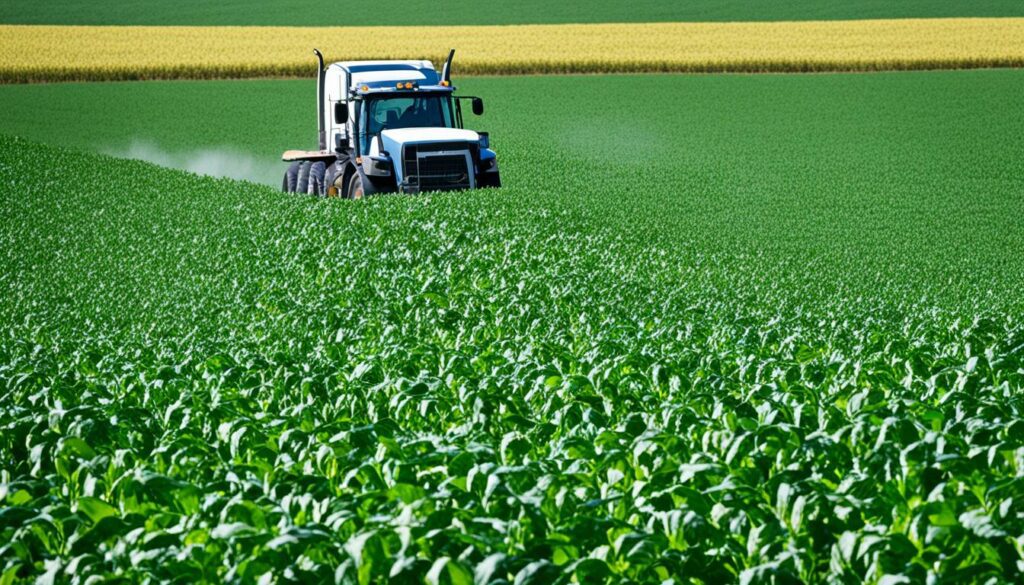
| Challenge | Mitigation Strategy | Benefit |
|---|---|---|
| Nitrogen Immobilisation | Use legume cover crops like hairy vetch | Reduces need for synthetic nitrogen fertilisers |
| Moisture Depletion | Early termination of cover crops | Ensures water availability for main crops |
| Weed Control | Grass cover crops like cereal rye | Efficient weed suppression and increased soil quality |
Farmers need to adjust their cover crop use depending on their area and crop types. Doing so can address the downsides well. By understanding the environment and acting at the right time, they can enjoy cover crops’ benefits fully.
Getting the most out of cover cropping involves learning key implementation techniques. Trying out small test areas first can show what works best for your soil. This helps match the right plant types with your soil’s specific needs. Setting up cover crops well increases soil’s water and nutrient-holding ability. It also lowers soil erosion and compaction.
Choosing the best time for cover cropping is important too. Thinking about when you plant cover crops improves how well they do in autumn’s cold, wet weather. This is crucial because wet seasons can make planting hard. Cover crops help by soaking up excess water, making fields ready for planting.
Picking cover crops that break down easily helps the soil. When these cover crops decompose, they enrich the soil, making it better for future crops.
It’s also smart to get advice from experts like those at University Extension or USDA Service Centers. These experts can help with choosing the right plants and how to manage them. Their help makes cover cropping more successful.
The table below shows some great cover crop options and what they do:
| Cover Crop Species | Primary Benefits |
|---|---|
| Hairy Vetch | Boosts no-till corn yields, nitrogen fixation |
| Red Clover | Improves soil nitrogen, fosters organic matter |
| Austrian Winter Peas | Supplies nitrogen, excellent for subsequent potato crops |
| Rye | Scavenges residual nitrogen, reduces erosion |
| Crimson Clover | Attracts pollinators, enriches soil fertility |
To end cover crops well, cut them when they’re flowering. Cut them close to the ground. This way, you can mix them back into the soil or use them in compost. After cutting, give the soil a few weeks. This lets the leftover plants and roots feed the soil for your next crops.
Cover crops do a lot for our planet. They help with carbon emissions and keep our water clean.They are a key player in fighting climate change. They also make farming better.
Cover crops are important in reducing our carbon footprint. They absorb CO2 from the air.This helps fight climate change. So, farms that use cover crops release less carbon into the air.This is because they don’t need as much machinery. Studies show they also help manage nutrients and lower greenhouse gases.
Cover crops make water cleaner, too. They stop soil from washing away and nutrients from running off.Their roots make the soil better at holding water and nutrients. This stops pollution from affecting our water.Also, cover crops improve the soil’s health. This helps keep water clean in both big and small ways.
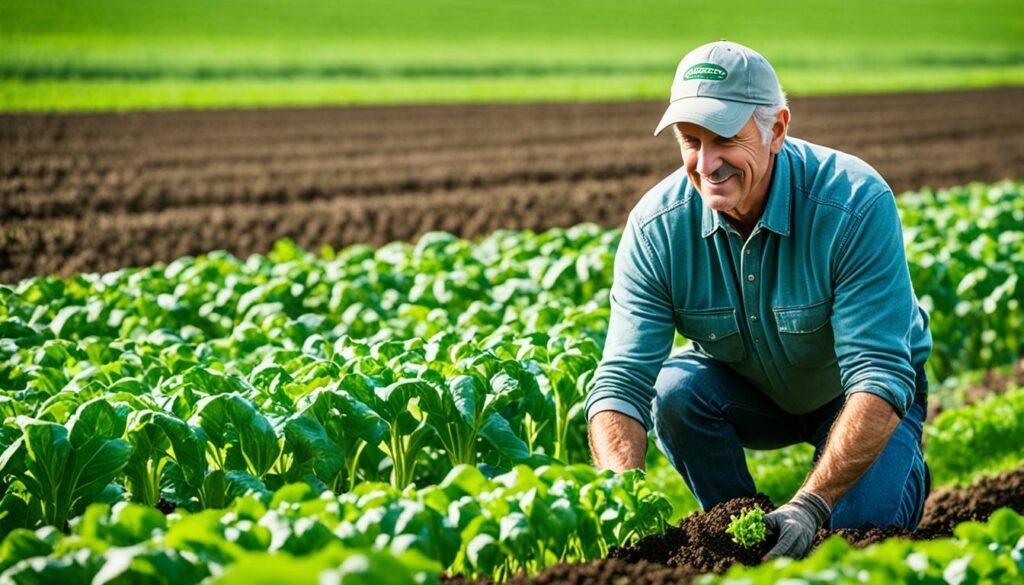
By using cover crops, farmers can reduce carbon and keep water cleaner. This is good for the environment. It shows how important cover crops are for making farming sustainable.
Urban gardens and backyard areas are improving thanks to cover crops. These plants help everything from big farms to small gardens. By using cover crops, the soil gets better, helping plants grow stronger.
Cover crops are great for urban areas. They stop soil from washing away, which is a big problem where many people live. They also make the soil healthier and more fertile. This is very important for small gardeners fighting against soil loss.
Success in urban cover cropping was seen in Washington, D.C., in 2021. The U.S. Department of Agriculture showed that cover crops cut CO2, made soil stronger against climate change, and helped water soak in. All these things are key for healthy city gardening.
Crimson clover, winter rye, and buckwheat work well in backyards. Crimson clover gives the soil nitrogen. Winter rye grows even in cold weather and keeps giving benefits in the spring. Buckwheat grows fast, cutting down weeds and making the soil better quickly.
Using cover crops not only makes soil healthier but also boosts crop yields and saves resources. It’s key for small gardeners wanting to grow a lot without harming the environment.
Planting cover crops in backyards adds lots of good stuff to the soil. This makes the soil richer and stronger. It also helps good bugs and animals live, making a nice ecosystem.
Cover crops are good for many reasons. They help fight pests, make the garden fuller of life, and save money on fertilisers. Many city gardeners are now using them a lot. Programs like the NRCS’s and support from the USDA can help new gardeners start using cover crops too.
Looking back at our study on cover cropping, it’s clear how vital it is. It’s at the heart of making farming sustainable. Cover crops improve the soil, save water, and help the economy. They also protect our environment, offering many solutions for the challenges we face.
One key benefit is seen with legume cover crops. These special plants can take nitrogen from the air and help other plants grow. This means farmers don’t need as much nitrogen fertiliser, saving money and helping the environment. Crops like vetch and clover are top choices because they provide good harvests and replace a lot of nitrogen.
Cover crops also fight off pests and suppress weeds. By planting rye and ryegrass, farmers can control harmful insects like soybean cyst nematodes. This reduces the need for chemical pesticides, which is good for both the crops and the land. By changing which crops are grown each year, farmers can protect against nematodes and keep their fields healthy.
These cover crops, such as rye and sorghum-sudangrass, do more than this. They also help build better soil. By adding nutrients and encouraging the growth of helpful microbes, they make the earth more productive. In arid areas, they’re also great at stopping soil from blowing away and keeping moisture in the ground.
Overall, cover cropping is a powerful technique in sustainable farming. By using these methods, we make agriculture better and the planet healthier. It’s a big step towards lasting success in farming and taking care of our environment.
Cover cropping isn’t just one benefit. It includes many, like making the soil healthier, stopping weeds, saving water, and recycling nutrients. It also helps keep the ground from washing away, supports more kinds of life, and traps carbon from the air.
Cover crops make the ground better in several ways. They help small organisms in the soil grow and make pathways for them. Plus, they stop the soil from washing away. They even make it easier for the earth to hold onto nutrients and capture carbon.
Cover crops often include grasses like rye, legumes like clover, and brassicas like radishes. Rye can help clean up extra nutrients in the soil. Clover can grab nitrogen from the air. Radishes are good for loosening tight soil.
Cover crops grow thick and tall, blocking out light and stealing nutrients. This makes it hard for weeds to grow. It’s a great way to keep weeds down without using lots of chemicals.
They help the earth soak up more water and stop it from running off. This keeps water where it’s needed. By making the soil spongier, cover crops use water better, which is good for farms.
Cover crops add to the soil’s living parts, which help feed the earth naturally. This means less need for extra chemicals. They can make the ground better at holding onto and giving out nutrients to crops later on.
Cover crops create homes and food for many different creatures, both above and below the ground. This makes the soil more alive and helps farms stay healthier.
Cover crops store carbon from the air, which is good for the planet. They also make the ground healthier over time. This is important for keeping farms going in the future.
When animals eat cover crops, they leave behind good stuff for the soil. This can be cheaper than buying feed and good for the ground. Mixing different animals and how they eat off the land can make better use of space and money.
Using cover crops can save money by making the farm work better. This includes having more stable harvests and spending less on extra stuff for the soil. In the end, it’s usually worth the start-up costs.
Sometimes, cover crops might use up too much water or nutrients that crops need. Finding the right plants, a good time to grow them, and some help from experts can solve this problem.
It’s smart to try a small area first to see what works. Pick plants that do good things for the soil or protect it. Plant and remove them at just the right times to get the most out of cover crops.
In cities and backyards, cover crops can keep the soil in place and make it full of life. This makes plants happy, leading to a garden that’s both fruitful and good for the earth.